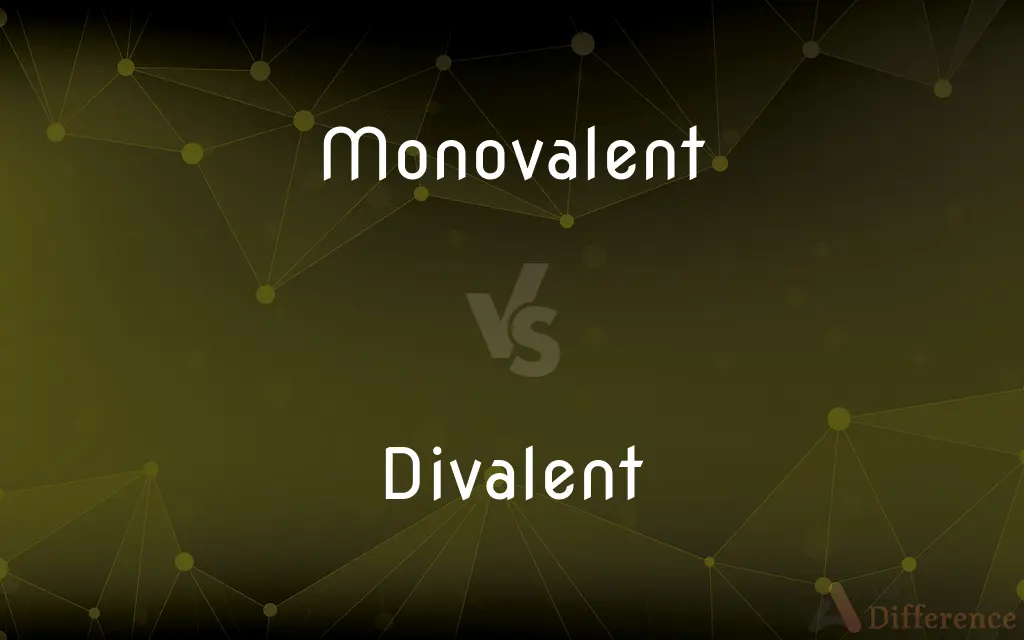Monovalent vs. Divalent — What's the Difference?
Edited by Tayyaba Rehman — By Maham Liaqat — Updated on April 17, 2024
Monovalent elements or compounds have a valence of one, indicating they can bond with or donate one electron, while divalent elements or compounds have a valence of two, able to bond with or donate two electrons.

Difference Between Monovalent and Divalent
Table of Contents
ADVERTISEMENT
Key Differences
Monovalent elements, such as sodium and potassium, form single bonds due to their single valence electron involved in bonding, making them highly reactive, particularly in forming ionic compounds. In contrast, divalent elements like calcium and magnesium can form two bonds with other atoms, often resulting in more stable compounds such as oxides and hydroxides.
In chemistry, monovalent ions like H+ and Na+ are crucial in processes like acid-base chemistry and electrical conductivity in solutions, whereas divalent ions like Ca2+ and Mg2+ play key roles in biological systems, including muscle contraction and neurotransmitter release, highlighting their significance in life processes.
Monovalent compounds are characterized by their ability to participate in reactions that involve single electron transfers, which is fundamental in redox reactions and electrical conductivity. On the other hand, divalent compounds are involved in more complex bonding and biochemical pathways, contributing to structures like the stability of proteins and cell membranes.
While monovalent atoms or ions typically result in less complex molecular structures and have applications in basic chemical reactions and manufacturing of simple salts, divalent atoms or ions contribute to the formation of more intricate molecular structures with applications in more diverse fields such as metallurgy, medicine, and biochemistry.
The reactivity of monovalent compounds generally leads to their use in straightforward, often commercial applications like detergents and soaps, whereas the reactivity of divalent compounds lends them to critical roles in more regulated environments, including human and plant biology, as well as in robust industrial processes.
ADVERTISEMENT
Comparison Chart
Valence
One
Two
Bonding
Single bonds
Double bonds or two single bonds
Common Elements
Sodium (Na), Potassium (K)
Calcium (Ca), Magnesium (Mg)
Role in Biology
Nerve impulse transmission, body fluids balance
Bone structure, enzyme functions
Industrial Use
Salts in detergents, batteries
Cements, supplements, metal alloys
Compare with Definitions
Monovalent
An ion with a single positive or negative charge.
The monovalent sodium ion plays a critical role in conducting nerve impulses.
Divalent
Having a valence of two.
Magnesium is a divalent element important in many biological processes.
Monovalent
Capable of forming one covalent bond.
The monovalent hydrogen ion, H+, is essential in acid-base reactions.
Divalent
Capable of forming two covalent bonds.
Oxygen often acts as a divalent atom in water.
Monovalent
Having a valence of one.
Potassium is a monovalent metal that reacts vigorously with water.
Divalent
An ion with a double positive or negative charge.
Calcium ions, Ca2+, are crucial for muscle function.
Monovalent
Involving single electron transfer.
Monovalent reactions are foundational in electrochemical cells.
Divalent
Pertaining to or derived from two base units.
Divalent vaccines protect against two different viruses.
Monovalent
Related to or derived from one base unit.
Monovalent vaccines are designed to immunize against a single organism.
Divalent
Involving the transfer or sharing of two electrons.
Divalent metal oxides are common in earth's crust.
Monovalent
Containing antigens from a single strain of a microorganism or virus. Used of a vaccine or serum.
Divalent
(Chemistry) Having a valence of 2.
Monovalent
Having only one site of attachment. Used of an antibody or antigen.
Divalent
Having two sites of attachment. Used of an antibody or antigen.
Monovalent
(Chemistry) Univalent.
Divalent
Containing antigens from two strains of a microorganism or virus. Used of a vaccine or serum.
Monovalent
(chemistry) univalent.
Divalent
(chemistry) Having an atomic valence of 2.
Monovalent
(chemistry) Any univalent substance.
Divalent
(medicine) Having a vaccine valence of 2.
Monovalent
Having a valence of one; univalent. See Univalent.
Divalent
(chemistry) Any divalent substance.
Monovalent
Containing only one kind of antibody
Divalent
Having two units of combining power; bivalent. Cf. Valence.
Monovalent
Having a valence of 1
Divalent
Having a valence of two or having two valences
Common Curiosities
What does monovalent mean in chemistry?
It refers to an element or ion with a single positive or negative charge, capable of forming one bond.
What are examples of divalent ions?
Calcium (Ca2+) and magnesium (Mg2+) are common examples of divalent ions.
Can the valency of an element change?
Yes, in different chemical environments or oxidation states, an element can exhibit different valencies.
What is the significance of divalent ions in biology?
Divalent ions are essential in structural functions like bone formation and play roles in metabolic pathways.
How do monovalent compounds differ from divalent compounds in industrial applications?
Monovalent compounds are often used in simpler applications like soaps and batteries, while divalent compounds are used in more structurally demanding contexts like cement and metal alloys.
How does valency affect chemical properties?
Valency determines how many electrons an atom can donate or accept, influencing its bonding behavior and compound stability.
Why is understanding valency important in chemistry?
Understanding valency helps in predicting how elements will interact in chemical reactions, aiding in everything from synthesizing new compounds to environmental remediation.
What educational background is needed to study the effects of valency?
A background in chemistry or a related scientific field is necessary to study and understand the implications of valency in various contexts.
What role do monovalent ions play in the human body?
They are crucial for maintaining fluid balance and transmitting nerve impulses.
Are monovalent or divalent ions more stable?
Divalent ions typically form more stable compounds due to their ability to make multiple bonds.
Share Your Discovery

Previous Comparison
Push vs. Shove
Next Comparison
Tichel vs. HijabAuthor Spotlight
Written by
Maham LiaqatEdited by
Tayyaba RehmanTayyaba Rehman is a distinguished writer, currently serving as a primary contributor to askdifference.com. As a researcher in semantics and etymology, Tayyaba's passion for the complexity of languages and their distinctions has found a perfect home on the platform. Tayyaba delves into the intricacies of language, distinguishing between commonly confused words and phrases, thereby providing clarity for readers worldwide.















































